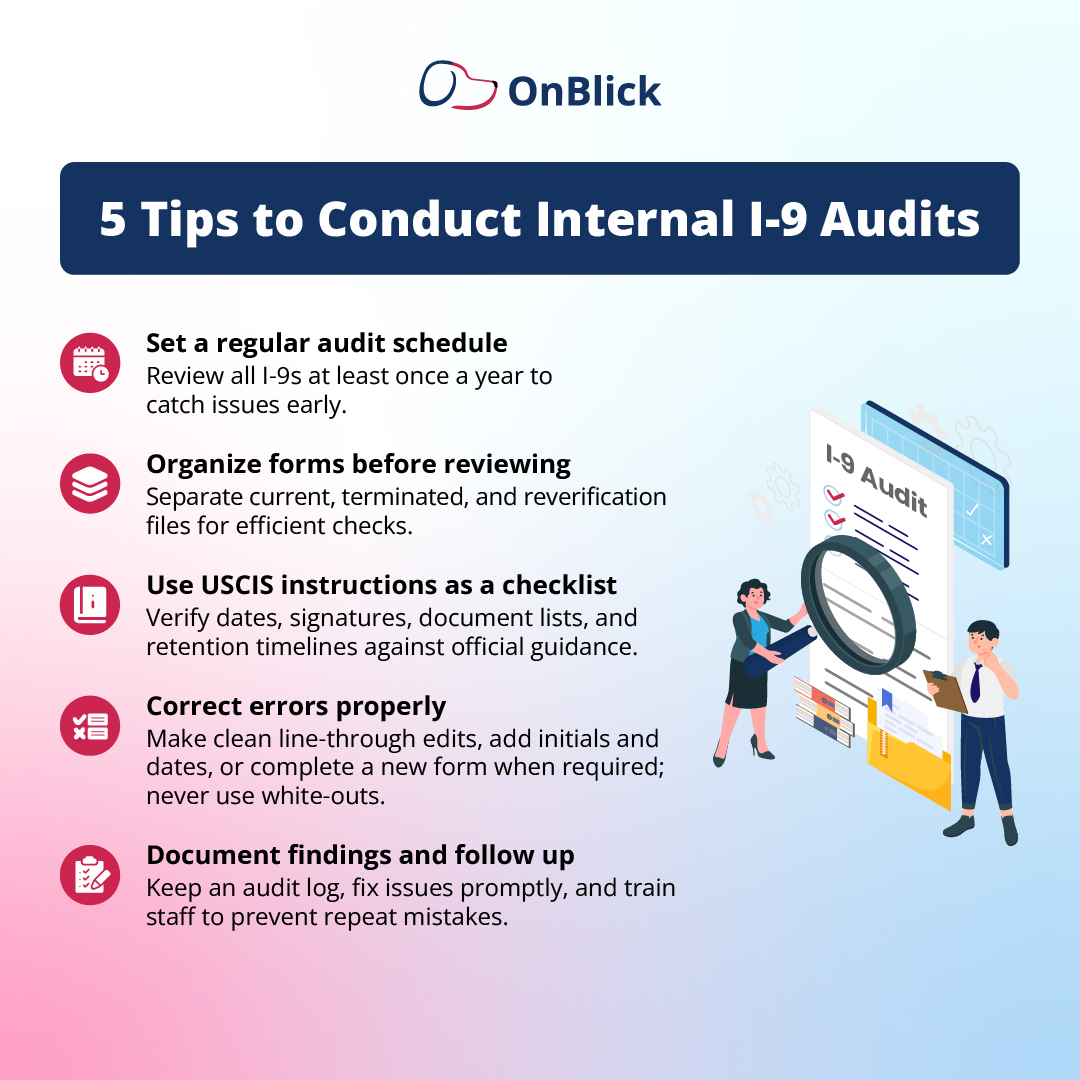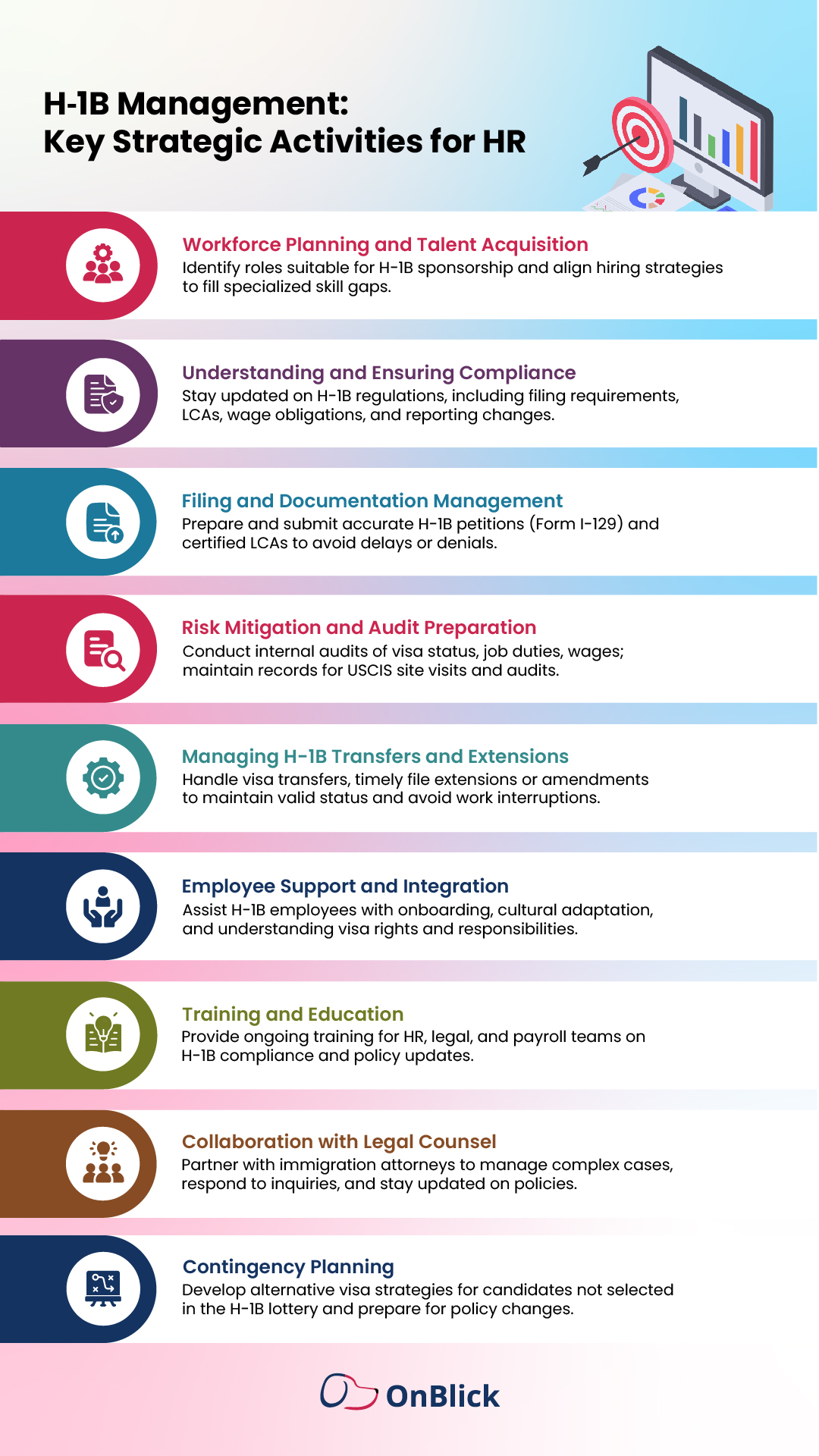Learn More

In today’s fast-changing market, many U.S. employers struggle to find professionals with the right skills. To bridge this gap, they leverage global talent with the help of the H-1B visa program, which allows them to hire the right talent and drive success. However, with this opportunity comes a responsibility of staying compliant with immigration rules, as even a minor mistake can lead to penalties, legal issues, or loss of workforce.
HRs play a key role in this process, as they are the first line of defense in managing compliance, guiding employees, and protecting the company’s interests. With the right approach, they can prevent violations, reduce risks, and ensure smooth business operations. This blog will explore how HR can safeguard organizations from H-1B compliance issues and adopt strategies that build trust, stability, and long-term success.
Every U.S. employer that hires H-1B workers must follow immigration guidelines. These rules exist to ensure that workers are treated fairly and that businesses comply with the law.
If a company does not follow the rules, it can face:
1. Financial penalties: Fines can range from hundreds to thousands of dollars, depending on the mistake.
2. Business restrictions: A company may lose the ability to hire more H-1B workers in the future.
3. Audits and inspections: USCIS may visit the company’s office to check if everything matches the paperwork.
4. Employee stress: Workers may feel unsafe and worried about their visa status. This affects their performance.
5. Reputation loss: Other businesses, clients, and even future employees may see the company as unreliable.
Following the rules, however, has the opposite effect. It creates benefits, such as:
1. Access to global talent: Companies can hire the best professionals from anywhere in the world.
2. Employee trust: Workers feel safe when they know their employer follows the law.
3. Smooth operations: A company with proper compliance has fewer disruptions from audits or investigations.
4. Strong reputation: A good compliance record makes the business look trustworthy and professional.
5. Long-term growth: Following the rules makes it easier to bring in more talent in the future and expand globally.
A workplace that prioritizes its H-1B compliance creates a stronger workplace and builds:
Many companies hire immigration lawyers, but lawyers are not involved in day-to-day operations. HR teams, on the other hand, are always in touch with both employees and company leaders. This makes HR the most important group when it comes to preventing H-1B violations.
HR makes sure that the information in the visa application matches what actually happens at work. For example, if a worker’s job title or salary changes, HR must record it and make updates where needed.
HR also connects three important areas:
• The law (immigration rules)
• The business (company goals and needs)
• The employees (their well-being and trust)
Without HR, communication gaps or small oversights could quickly turn into major compliance issues.
While H‑1B compliance has many requirements, certain areas tend to cause the most issues. Focusing on the points below can help HR avoid costly mistakes.
No matter how manageable H-1B compliance seems, HR must proactively avoid these common pitfalls to ensure a steady and stable compliance culture:
1. Informal job changes: Employees shouldn’t be allowed to manage more responsibilities without updating the H-1B petition.
2. Incomplete documentation: A frequent mistake is neglecting the Public Access File (PAF) with required items like the certified LCA, wage details, and posting notices. Missing or outdated records can lead to compliance issues and penalties. HR must keep all H‑1B files accurate, updated, and audit‑ready.
3. Delayed updates: Failing to report changes in salary, location, or job role can lead to compliance issues that affect the daily operations of an organization.
4. Lack of training: All employees and leaders must be trained in handling site visits and sudden audits to mitigate common errors and facilitate a smooth process.
5. Overreliance on legal terms: Leveraging legal help is fine, but completely depending on it can lead to overlooked day-to-day compliance issues that HR should take care of.
A compliance-driven culture requires great attention to detail and discipline. HR leaders must follow a structured approach that is easy to implement. Some proactive steps HR should take are:

Preventing H-1B violations isn’t a one-time thing. It’s all about building a workplace where rules are followed and employees feel secure.
Here’s how HR can create a compliance-driven culture:
1. Clear policies: HR should draft clear policies for all departments that are easy to understand for both managers and employees.
2. Consistent training: Regular workshops should be organized to keep employees and H-1B employers updated on any changes in rules or regulations.
3. Open dialogue: HR should promote direct and open communication, so employees feel confident enough to follow it personally.
4. Shared responsibility: Compliance isn’t solely dependent on HR. It requires team effort and accountability. HR leaders should try to promote a culture of accountability, so teams feel equally responsible.
5. Proactive Monitoring: Regular interviews and audits should be conducted to identify potential compliance gaps at the earliest.

Managing compliance with the H-1B program is a complex responsibility, and HR is usually at the forefront of ensuring organizations meet every regulatory requirement. They are required to monitor, document, and support both employees and leadership, which makes it essential to stay proactive and consistent to prevent violations and protect the business. To ensure compliance and build a resilient workforce, HR should follow best practices, conduct regular audits, and foster a culture of transparency.
Streamline your H-1B compliance with OnBlick. Our expert-driven platform simplifies immigration compliance and minimizes risks. We offer end-to-end support for all compliance needs, including LCA filing, Public Access File management, and audit preparedness, so your organization can focus on growth with confidence.
Book your free demo today and learn more about our H-1B case management services.
.jpg)